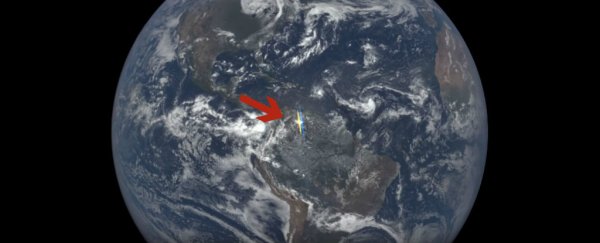Hundreds of large flashes have been filmed reflecting off our planet, and they've helped NASA solve a mystery that stumped the likes of Carl Sagan more than two decades ago.
These flashes are so large, you can see them from space, and they were originally thought to be caused by sunlight reflecting off the surface of the ocean. But then NASA started spotting them on land, and no one could say why.
"We found quite a few very bright flashes over land as well," says Alexander Marshak from NASA's Goddard Space Flight Centre.
"When I first saw it I thought maybe there was some water there, or a lake the sun reflects off of. But the glint is pretty big, so it wasn't that."
Back in 1993, astronomer Carl Sagan noticed strange flashes of light showing up in images of Earth taken by the Galileo spacecraft.
The unmanned space probe had been launched four years earlier to study Jupiter and its moons, but Sagan and his team decided to take advantage of one of its flybys past Earth, and scoured the data for signs of life on our own planet.
The idea was that if he could detect signatures of life on Earth from way up in space, any undiscovered extraterrestrial neighbours could too, and know from afar that our planet was inhabited.
In Galileo's images, they found large glints of light, reflecting like mirrors - but he could only find them in regions of the planet covered in water.
"Large expanses of blue ocean and apparent coastlines are present, and close examination of the images shows a region of specular [mirror-like] reflection in ocean, but not on land," the team reported at the time.
It came as quite a shock, then, when 24 years later, NASA detected 866 bursts of light between June 2015 and August 2016, and they were all coming from the land.
You can see them in the footage below, which was shot by NASA's Earth Polychromatic Imaging Camera (EPIC) onboard the NOAA's Deep Space Climate Observatory (DSCOVR):

When the NASA team dug out the old Galileo photos for comparison, they realised that Sagan and his team had missed a rather crucial detail - those strange reflections had actually appeared on land during that survey too.
Tasked with explaining this bizarre phenomenon, Marshak and his team catalogued all known flashes over land from the Galileo and EPIC images, and mapped out their locations.
They hypothesised that if the glints were caused by reflected sunlight, then only certain parts of the globe could have them - spots where the angle between the Sun and Earth was the same as the angle between the spacecraft and Earth, which would allow the spacecraft to pick up the reflected light.
Sure enough, that pattern emerged, and this helped them discount one potential cause of the glints - lightning.
"Lightning doesn't care about the Sun and EPIC's location," says Marshak.
To figure out what the sunlight was actually reflecting off, the team proposed that water is still the culprit, but up in the atmosphere, rather on the surface.
Using data from EPIC, they were able to map out where exactly the glints were coming from, and narrowed down the source to 5 to 8 km (3 to 5 miles) above the surface, where cirrus clouds full of ice crystals hang.
When they modelled the direction of sunlight reflecting off hypothetical ice crystals that happened to be floating in the air on a horizontal angle, the numbers matched perfectly to what was in the EPIC and Galileo images.
"The source of the flashes is definitely not on the ground. It's definitely ice, and most likely solar reflection off of horizontally oriented particles," says Marshak.
The research has yet to be peer-reviewed, so certain aspects of the discovery could change once it's been independently verified
But the researchers are now looking into how common these horizontal ice crystals actually are, and if they're having any significant impact on how much sunlight is being reflected through our atmosphere.
And at least we now know one thing for sure - these aren't the signs of life Carl Sagan was looking for.
You can see all the images from EPIC at NASA's website.
